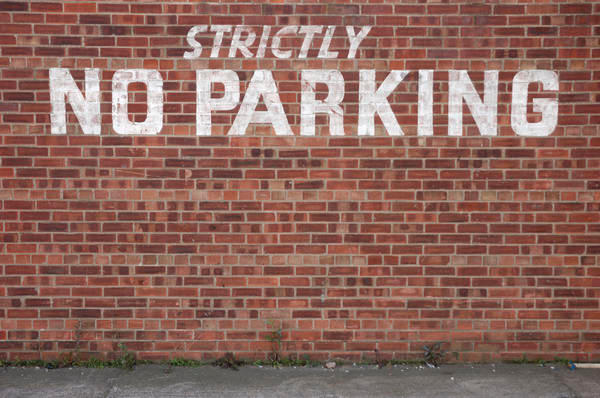The 8-mph speeding ticket and other automotive firsts
Did you know that France issued the world's first driver's licenses 15 years before the Henry Ford unveiled the Model T in 1908? Or that Britain adopted speed limits in the mid-1800s? Or that the earliest "No Parking" zone dates back to around 700 B.C.?
From license plates to car insurance, many of the laws and practices that drivers take for granted today came about at the automobile era's dawn in the late 1800s -- if not earlier.
"Laws about cars stem from the idea that the road itself should be regulated, and that's a concept that goes really far back in (Western) common law, probably back to the 15th or 16th century," says Catharine Wells, a Boston College Law School professor.
Experts don't necessarily agree on when some of today's automotive laws and practices initially appeared, but the dates that follow reflect the earliest instances documented by credible sources.
First 'No Parking' zone: c. 700 B.C.
The earliest known "No Parking" sign dates back to the reign of Assyrian King Sennacherib in 705-681 B.C., according to a 1954 book on traffic by New York Times transportation reporter Joseph C. Ingraham.
Ingraham wrote that a sign on the Assyrian capital of Nineveh's main thoroughfare read: "Royal Road -- Let No Man Decrease It." No one could park a chariot there under penalty of death.
(Source: Modern Traffic Control, by Joseph C. Ingraham)
First traffic signal: 1868
The first traffic signal arrived decades before gas-powered autos did, appearing near London's House of Parliament in 1868 to regulate pedestrians, horses and horse-drawn wagons. It consisted of red, yellow and green gas lights operated by a police officer, but only lasted a month before a leak caused one of the lamps to explode, seriously injuring or killing the operator -- accounts differ.
The first electric traffic light was invented in 1912 by a Utah policeman named Lester Wire. Installed in Salt Lake City in 1914, it had red and green lights that a police officer manually operated. Automated operation began in 1926.
The first red/yellow/green electric traffic signal appeared in Detroit in 1920, the brainchild of local policeman William Potts.
(Source: Famous First Facts, University of London Victoria County History project)
First speed limit: mid-1800s
The earliest speed limits harken back to at least the mid-19th century, often backed by railroads and carriage-makers that wanted to stifle development of steam vehicles (and later of gas-powered cars).
For example, Britain's 1861 Locomotive Act restricted early vehicles to just 10 miles per hour in rural areas and 5 mph in urban ones.
An 1865 revision was even stricter, setting speed limits at 4 mph in the country and 2 mph in cities and towns. Drivers also had to have someone to walk in front of their cars with a red flag. (U.K. car enthusiasts have celebrated that law's 1896 repeal with an annual London-to-Brighton road race ever since.)
America's earliest speed limit dates back to 1901, when Connecticut set a 12 mph maximum for the country and 8 mph for cities. Congress set America's famous 55 mph federal speed limit for all highways in 1974 to save gas amid the Arab oil embargo, but repealed the unpopular law 21 years later.
Today, 37 states have highway speed limits of 70 mph or higher.
(Source: British National Archives, British Royal Automobile Club, Book of Firsts)
First speeding ticket: 1896
Britain issued the earliest recorded speeding ticket in 1896, when authorities cited Walter Arnold of East Peckham, some 35 miles southeast of London.
Arnold was traveling through the town at 8 mph, or four times the 2 mph speed limit. A policeman on a bicycle caught up with the scofflaw, who ended up paying court costs and a 1-shilling fine (about eight U.S. cents at current exchange rates).
Today, U.S. motorists rack up about 112,000 speeding tickets a day, usually for going considerably faster than 8 mph. Not all insurance companies will raise rates for a single violation, but among those that do, the average increase after a speeding ticket is 11 percent.
(Source: British National Motor Museum)
The first license plate: 1889
France issued the world's first license plate to a Paris driver in 1889, with New York state requiring America's first such plates two years later.
Empire State drivers originally furnished their own license plates, writing their initials in 3-inch-high letters and providing the details to authorities. But Massachusetts unveiled America's first government-issued plates in 1903, giving a local driver a dark-blue one with the number "1" and "Mass. Automobile Register" written in white.
Connecticut offered the first vanity plates in 1937. Car owners with five years of good driving could pick three letters (usually their initials) to display on their plates.
(Source: Famous First Facts)
First car accident: 1891
The earliest recorded accident involving a gas-powered car occurred nearly two decades before the Model T.
Auto pioneer J.W. Lambert hit a tree root and careened into a hitching post in 1891 while driving a one-cylinder vehicle in Ohio City, now part of Cleveland. He and a friend sustained minor injuries.
Today, U.S. drivers are involved in about 6 million accidents a year. Even a small on your claims record can raise your rates; an Insurance.com survey of major carriers found an average increase of 18 percent.
(Source: Famous First Facts, Ohio History Central, Robertson's Book of Firsts)
First driver's license: 1893
Paris police instituted both the world's first driver's licenses and driving tests in 1893.
As for America, Massachusetts in 1903 became the first state to require a driver's license, followed shortly thereafter by Missouri. Neither mandated road tests, which didn't come to America until Rhode Island began requiring them as part of a driver's license law it adopted in 1908.
The first provisional licenses/learner's permits for young drivers date back to 1979, when Maryland began issuing them to those under 18. These licenses lasted for six months and limited such things as teens' night-time driving.
Today, your motor vehicle record - a listing of every reported accident and moving violation - determines whether you keep your driver's license, usually through . Insurance companies use the same record to calculate your rates.
(Source: British National Motor Museum, Famous First Facts, Robertson's Book of Firsts)
First auto-related fatality: 1896
The first fatal accident involving a gas-powered automobile took place in 1896 at London's Crystal Palace park, when a car participating in an auto exhibition struck and killed 44-year-old Bridget Driscoll. She apparently froze in panic as the vehicle approached at 4 mph.
The first fatal U.S. accident occurred in New York City in 1899, when an electric-powered cab struck a 68-year-old at the corner of 74th Street and Central Park West as the man was exiting a streetcar. The victim eventually died and police charged the cabbie with manslaughter, but a court ruled the death unintentional and acquitted him.
Today, about 33,000 people a year die in automobile-related accidents.
(Source: British National Motor Museum, Famous First Facts, Robertson's Book of Firsts)
First car-insurance policy: 1896
Early car accidents and fatalities brought the need for auto insurance, and 19th-century underwriters were only too happy to oblige.
London's General Accident Co. began offering car owners coverage in 1896, with clients negotiating their policies' terms and rates individually.
Scottish Employers' Insurance Co. unveiled the world's first standardized auto-insurance rates a few weeks later. The firm charged 30 shillings (around $2.34 in today's terms) as a base rate, plus an extra 30 shillings for every 100 British pounds ($156 in today's money) of coverage.
London drivers had to pay an additional 25 percent, while policies specifically excluded damage caused by frightened horses.
The first U.S. policy dates back to 1897, when a Massachusetts mechanic paid $7.50 for $1,000 of custom coverage on his homemade one-cylinder car. The first standard auto policy arrived one year later, when Travelers Insurance sold a Buffalo, N.Y., doctor $5,000 of liability coverage for $11.25.
Today, according to an analysis of more than 550,000 quotes delivered through Insurance.com, the most common coverage levels chosen are $50,000 in bodily injury liability ($100,000 per accident) and $50,000 in property damage liability. (See Insurance.com's auto insurance coverage calculator to see what drivers like you choose.)
(Source: Robertson's Book of Firsts)
First parking meter: 1935
Oklahoma City installed the world's first parking meter at the corner of First Street and Robinson Avenue in 1935, charging a nickel an hour.
"Park-O-Meter No. 1" and its brethren aimed to combat a growing shortage of parking spaces that stemmed from the fact that Oklahoma residents' registered cars exploded from 3,000 in 1913 to 500,000 by 1930.
Local newspaper editor Carl Magee, who chaired a local chamber of commerce committee tasked with solving the problem, came up with the idea of parking meters. He teamed up with two engineering professors from Oklahoma State College (now Oklahoma State University) to perfect the device.
Although some drivers viewed the meters as an illegal tax on their cars, retailers loved that the devices created parking-space turnover for customers. The idea caught on nationwide, and America had more than 140,000 parking meters by the early 1940s.
Park-O-Meter No. 1 currently resides at the Oklahoma Historical Society museum, while the company that Magee and the professors set up to make parking meters still exists as Arkansas-based POM Inc.
(Source, Book of Firsts, History.com, Moneyweek, POM Inc., October 1935 Popular Mechanics)
First parking ticket: 1935
Not surprisingly, the earliest parking ticket quickly followed the first parking meters.
Shortly after Oklahoma City unveiled meters in 1935, local Rev. C.H. North stopped at a space and didn't have the correct change to deposit. So, he went into a nearby store to get some -- only to find the world's first parking ticket dangling from his car's windshield by the time he returned.
North is said to have gone to court to explain why he didn't deserve a ticket. By most accounts, he beat the rap.
Today New York City alone issues more than 10 million parking tickets a year.
(Source: Los Angeles Times, New York Times, Moneyweek, The (Oklahoma City) Oklahoman)
The original article can be found at Insurance.com:
Related articles

 Yahoo Finance
Yahoo Finance 



